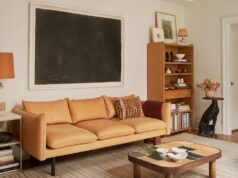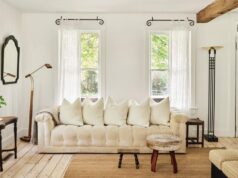The ceramic clinks of coffee cups meeting their saucers maintain a consistent chime in the lobby at the Mercer Hotel in SoHo. Halfway through his cappuccino, Charles Zana scans the room to admire the morning bustle. It’s been more than a year since the French AD100 architect and interior designer has been back to New York, and this trip’s agenda is making up for lost time: site visits to an in-the-works restaurant on Crosby Street and a residential project near Bedford, New York, before jetting off to much sunnier L.A. Though none of those are this morning’s priority.
Sliding his cup to the edge of the table, Zana pulls a look book from his bag and displays it on the table. Beautifully presented within it are the 60 furniture and lighting designs—half iterations from client projects, the other half brand-new—that make up the inaugural ensemble for Charles Zana Mobilier, set to launch on February 17 online and in a new Paris showroom on Rue de Seine, adjacent to his studio.
“It’s a start, but it’s not a start,” Zana prefaces. “For 30 years, I have been designing furniture [for client projects]. Now, it’s just talking about the furniture without talking about the project.” Though, if observation is any teacher, Zana is well prepared. The son of an art and design collector, Tunisian-born, Parisian-bred Zana was accustomed to the modern works of Pierre Paulin, Jean Royère, and Gae Aulenti, among others, in the family room growing up. It was that exposure and eventual interest in furniture design that led him to pursue architecture studies at the École des Beaux-Arts. Three decades of designing international residential and hospitality projects later, “it’s like a rebirth. I’m going back to my first love,” he says.
Fittingly, in context, it’s a love one can really feel thanks to the furniture and lighting’s intentionally tactile palette ranging from rigid, brushed oak to patinated bronze, sleek black Marquina marble and travertine to velvet and suede upholsteries. “It’s very sensitive, and I love that,” he says of the latter, which repeatedly pops up throughout the collection’s sofas and stools, adding a seductive depth to the S-curved Julia sofa and the Teddy headboard.
Zana takes the personification one step further by describing a desire for his furniture to evoke an emotion, to “extract from the essence” of design. He does so best in doing just that: extracting, refining, and freeing of flourish. Take the Milos lamp, where vertical trimmings along the travertine base create a grooved detail. There’s also the Warton armchair, inspired by the works of American Arts and Crafts artist Wharton Esherik, and the Frank Bridge armchair, which keeps in mind Zana’s fondness for playing with proportion with a bulbous seat. Both patinated bronze chair frames are noticeably skinny, their arms and legs thinly stretched from the back as though molten glass quickly pulled to shape before it cools.
Despite the removal of decoration—a nod to Shaker-style influences which Zana foresees as “the next fashion furniture people will want after the pandemic, a return to real work by hand and utility”—there is one motif that reappears throughout the series: an infinity curve. Often extracted from the wood surfaces to create a sculptural inverted handle, as with the Nomad stool and its counter-height Big Nomad stool, the design choice has more than simply functional appeal, Zana says. “It’s a never-ending symbol of love.” An emblem of tradition, much like the legacy of French craftsmanship or the design appreciation passed from father to son.
“You have a soul behind the pieces when it’s made by man and when it’s made by a tradition, and I believe strongly that what the people will love is to have modern furniture built using traditional techniques,” Zana says. “This is the new luxury. Not to have something super modern and complicated to produce, but to go through traditional textiles, traditional metals, traditional wood with this less-is-more kind of spirit.”
Last fall, during the FIAC art fair in Paris, Zana tested his theory by offering a first look at the Mobilier in an exhibition dubbed “Ithaque.” An 18th-century town house—its interiors profuse with faded silk wall coverings and architectural blemishes—became a poetically minimal backdrop for the refined designs, in addition to paintings by French Israeli artist Nathanaëlle Herbelin.
By now, the Mercer’s morning bustling has evolved into a lunchtime crowd. Raising his voice among the escalated chatter, Zana thinks back to the weeks leading up to the exhibition opening, recalling his nerves: “When you do an exhibition like that, you’re kind of nude presenting yourself,” he says. No more using the client as a barrier for a project, or its process for explanation. “When you talk about furniture, you present a part of yourself–and all that you can do is stand back and show something that’s finished.” There’s no façade involved. Well, unless you count the good-looking one coming to Paris’s 13 Rue de Seine next month, that is.








